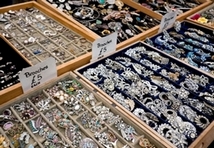|
Antique Diamonds
Antique Diamonds, vintage gemstones with real value which dates back to earlier time periods. Some vintage gems go back to the mid 1800's and 1900's from different parts of the world. There are four (4) different antique cut diamonds: Rose Cut Diamond, Old Mine Cut Diamond, Old European Cut Diamond and Table Cut Diamond.
The Rose Cut Diamond came after the Table Cut Diamond as a newer and more fashionable way for cutting diamonds. They were the more favorable style cuts in the 18th and 19th century until the brilliant cuts came into fashion. The Rose Cut was found often in the Georgian revival jewelry and up to the 20th century. The rose cuts have two basic forms: single rose cut and double rose cut.
The single rose cut antique diamond ring has a single layer of facets in a surround of smaller diamonds on it. The double rose cut antique diamond ring has two horizontal layers of facets in the center stone. Dutch rose cuts, what double rose cuts are usually called, are very high or deep with two or three rows of horizontal facets. Some facets structures are vague others are more structured in their designs. These rose cuts are usually out of round. They are never perfectly round, unless the cuts are made by modern day diamond cutting machines.
Old Mine Cut Diamond were brilliant cut forms with a variety of facet structures and out-of-round more like a square or rectangle shape on a ring. This diamond ring dates back to the 18th and 19th centuries in the Georgian and Victorian style jewelry. Old Mine Cuts were hand-made with precision not by machines in those days. Their features is an open culet with a large table. Usually the open culet has facets that come together at the bottom and leaves a small flat surface. A second type of an old mine cuts antique diamond is where the irregular perimeter has no two diamonds alike and the black dot or open culet is at the base of the stone.
Antique Jewelry Stall
The Old European Cut Diamond are diamonds with a variety of facets and a form of a brilliant cut. It has about fifty eight (58) facets with key features of a large table, an open culet and a round perimeter or shape. The bruting machine made a girdle (outer most edge of a diamond) or perimeter to be round and not irregular, which made this diamond features closer to modern diamonds. Table Cut Diamond are diamonds that were named table cut, because of its flat top which looks like an ordinary table. It has four sides with facets similar to a bevel (a surface that does not form a right angle with adjacent surfaces). These gems were found in the 16th century and more often put to use in the earlier 18th century jewelry. These diamonds had cuts and setting styles that have changed throughout history. The four cut diamonds above were mostly hand cut and polished until the early 19th century when modern technology brought the cutting machines that made cutting diamonds into near perfection easier for the cutters. From Antique Diamonds Back To Home Page
|






